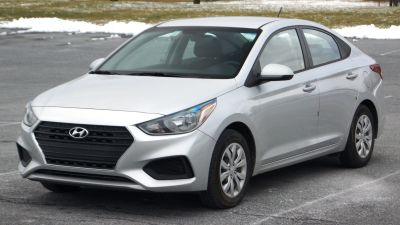Hyundai Verna

- Year: 1994
- Status: in_production
- Price: ₹11.07 - ₹17.58 lakh
The Hyundai Verna is a compact sedan that positions itself as a stylish and feature-packed option in the competitive sedan market. This model emphasizes a premium driving experience, incorporating sophisticated design elements both inside and out. The Verna boasts a sporty exterior profile, often featuring sleek lines and advanced lighting technology. Under the hood, it offers a choice of efficient petrol and diesel engines, paired with either manual or automatic transmissions. Inside, the cabin focuses on comfort and technology, typically featuring a large touchscreen infotainment system with advanced connectivity options, premium upholstery, and a range of driver-assistance features. The Verna targets buyers seeking a blend of style, performance, and technology, placing it above the entry-level sedans while remaining competitive in pricing compared to its segment rivals.
Generations
First generation (X3; 1994)
The first generation Hyundai Verna (X3), released in 1994, was a compact sedan primarily aimed at the South Korean market. Positioned as a budget-friendly option, it featured relatively basic styling and technology, reflecting the automotive landscape of the time. Engine options were generally small-capacity petrol units, prioritizing fuel economy over outright performance. While not particularly sophisticated, the X3 served as a crucial stepping stone for Hyundai, helping to build brand recognition and establish a foothold in the increasingly competitive automotive market. Its design was unassuming and functional, prioritizing practicality and affordability.
Second generation (LC; 1999)
The second generation Hyundai Verna (LC), launched in 1999, marked a modest upgrade from its predecessor. While still targeting budget-conscious consumers, the LC presented a slightly more refined design and improved interior space compared to the X3. Engine options remained relatively small-capacity, but efficiency and reliability were prioritized. Safety features were modestly enhanced, reflecting progress in automotive safety standards. The LC’s improvements were evolutionary rather than revolutionary, aiming to refine the original Verna’s formula while remaining competitive in its price segment. It solidified the Verna's place as a reliable and affordable option in emerging markets.
Third generation (MC; 2005)
The Hyundai Verna's third generation (MC, 2005-2010) marked a significant step up for the model, moving away from its previous boxy design. This generation featured a more fluid, aerodynamic profile, incorporating a more modern and refined aesthetic compared to its predecessor. Mechanically, it offered a range of petrol and diesel engines, coupled with either manual or automatic transmissions. While still a compact sedan, the MC Verna aimed for a more upmarket feel, boasting improved interior quality and a longer wheelbase for increased passenger comfort. This generation solidified the Verna's position as a strong competitor in the burgeoning compact sedan segment in several Asian markets, though its technological features remained relatively basic by modern standards. Safety features were also rudimentary compared to later models, often varying based on specific trim levels and regional specifications.
Fourth generation (RB/RC; 2010)
The Hyundai Verna's fourth generation (RB/RC, 2010-2017) represented a considerable leap forward. This generation embraced a more sculpted and aggressive design language, distinguishing itself visually from its predecessor. Significant upgrades were made across the board, including improved engine options with better fuel efficiency and performance. Interior refinement also took a notable step forward, with the inclusion of more advanced technology features, such as touchscreen infotainment systems (depending on trim level) and enhanced comfort features. Safety significantly improved with the addition of features such as airbags and ABS becoming more standard across the lineup. The RB/RC Verna was a successful generation, establishing a stronger global presence for the model and attracting a broader customer base thanks to a balance of style, performance, and features.
Fifth generation (HC/YC; 2017)
The fifth-generation Hyundai Verna (HC/YC, 2017-2023) showcased a dramatic shift in design philosophy, adopting Hyundai's then-current "Fluidic Sculpture 2.0" design language. This resulted in a more sophisticated and elegant appearance, characterized by sharper lines and a more premium feel. This generation prioritized technology integration, offering larger touchscreen infotainment systems with smartphone connectivity as a standard feature across most trim levels. Engine options were refined for better fuel efficiency and power output, and safety features were further enhanced, often including multiple airbags, electronic stability control (ESC), and advanced driver-assistance systems (ADAS) depending on the trim and region. The overall build quality also improved, resulting in a more refined and quieter driving experience. This iteration saw the Verna become more competitive in global markets, competing successfully against established rivals.
Sixth generation (BN7; 2023)
The sixth-generation Hyundai Verna (BN7, 2023-present) represents the most technologically advanced and stylish iteration to date. This generation boasts a bold and contemporary design, emphasizing a sporty and sophisticated aesthetic. The interior is significantly upgraded, featuring a completely redesigned dashboard with a prominent digital instrument cluster and a large, high-resolution touchscreen infotainment system, often incorporating the latest connectivity features. Significant advancements are seen in safety technology, incorporating advanced driver-assistance systems such as adaptive cruise control, lane keeping assist, and autonomous emergency braking, pushing it into the realm of more premium competitors. Engine options emphasize fuel efficiency and performance, often including more advanced powertrain technologies. Overall, the BN7 Verna establishes a significant benchmark for the compact sedan segment with its blend of style, technology, and safety.